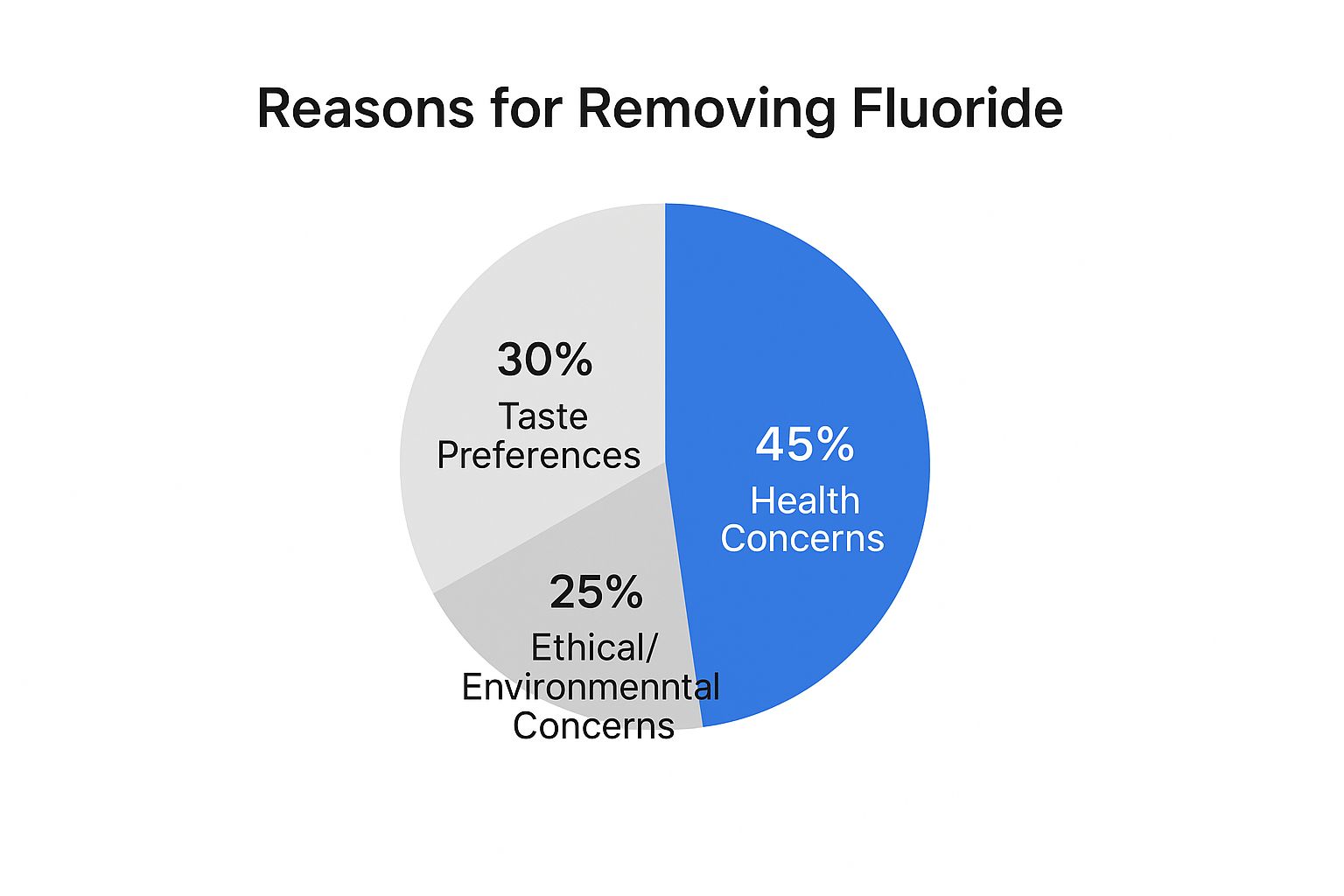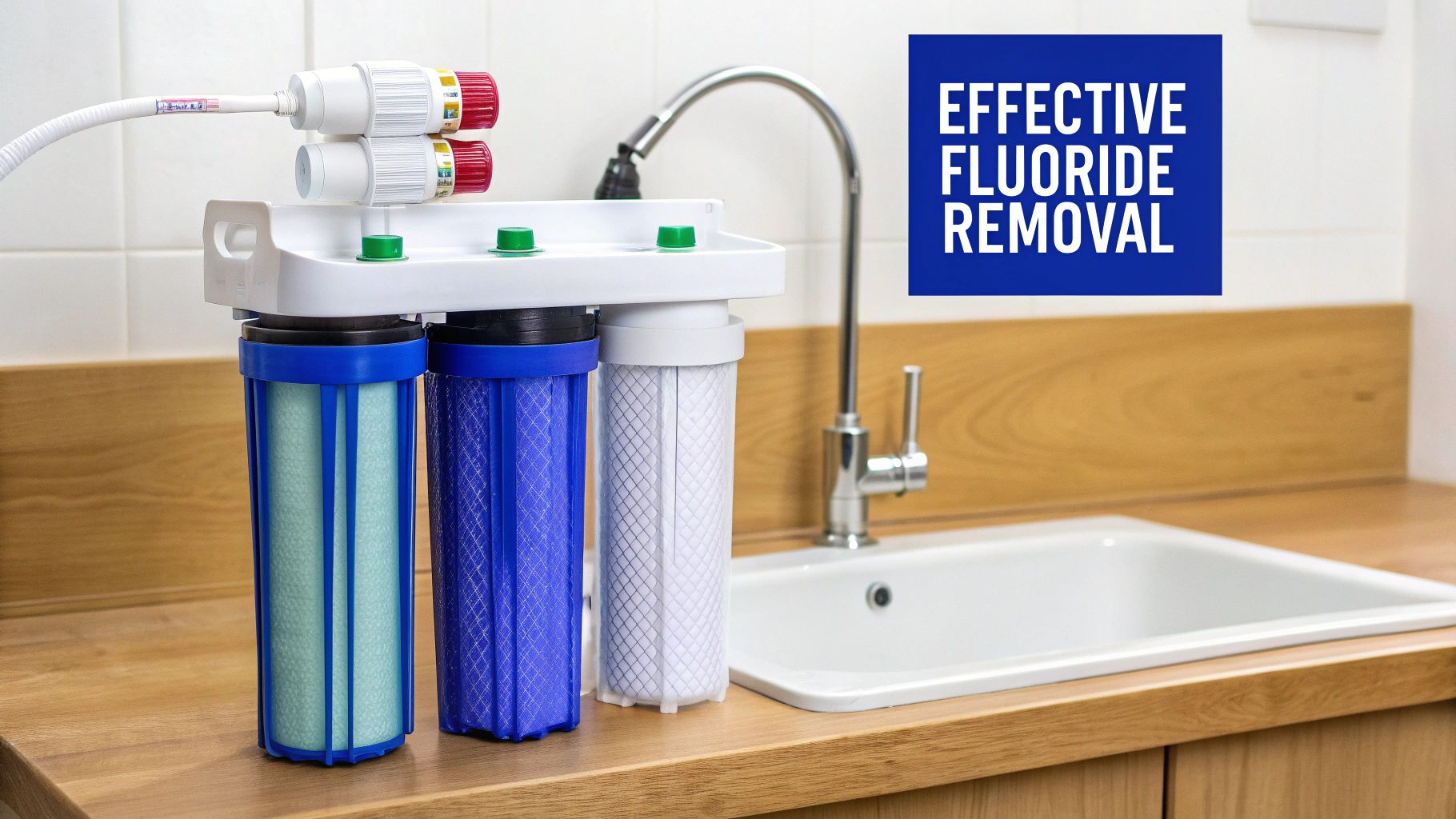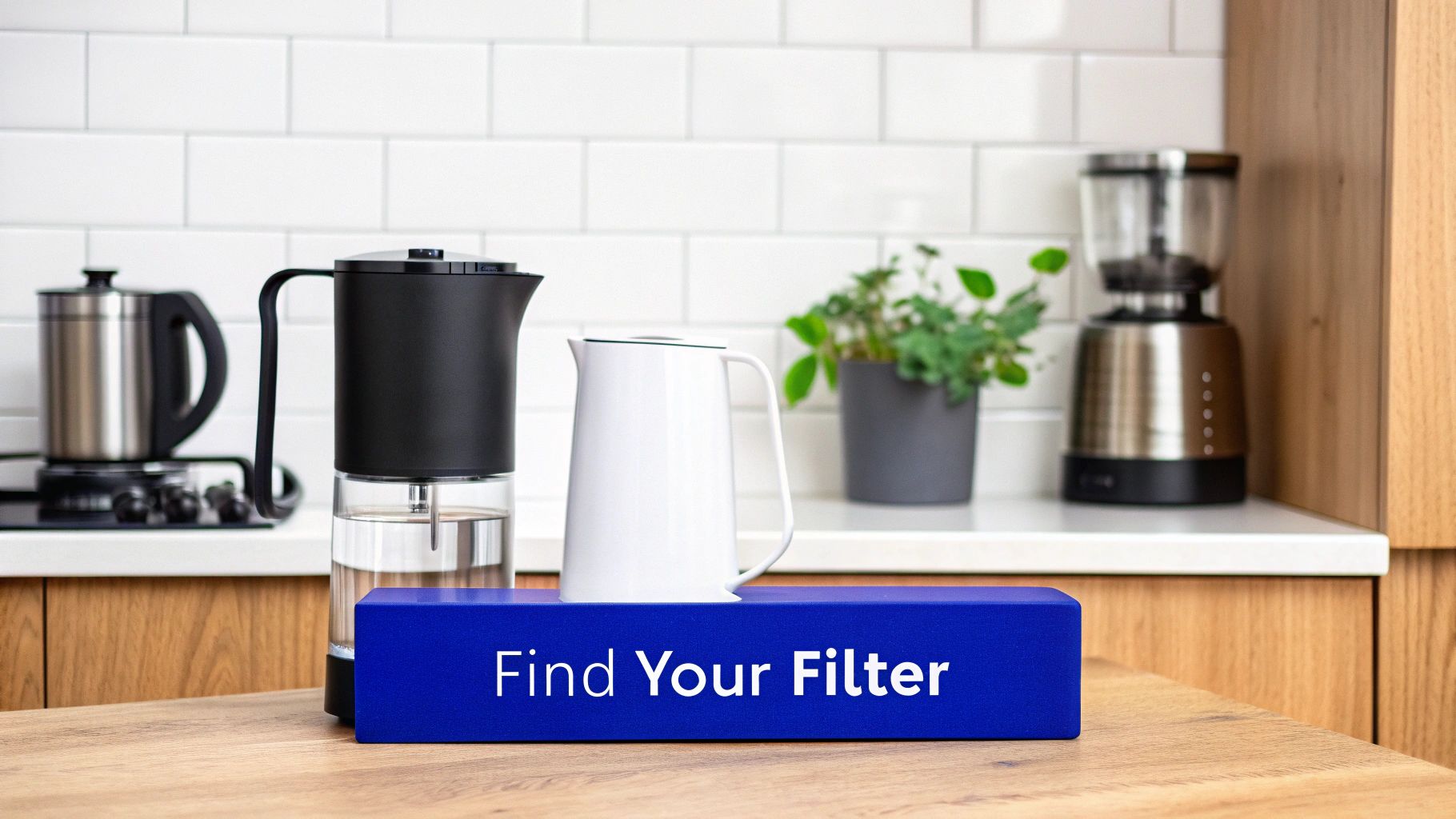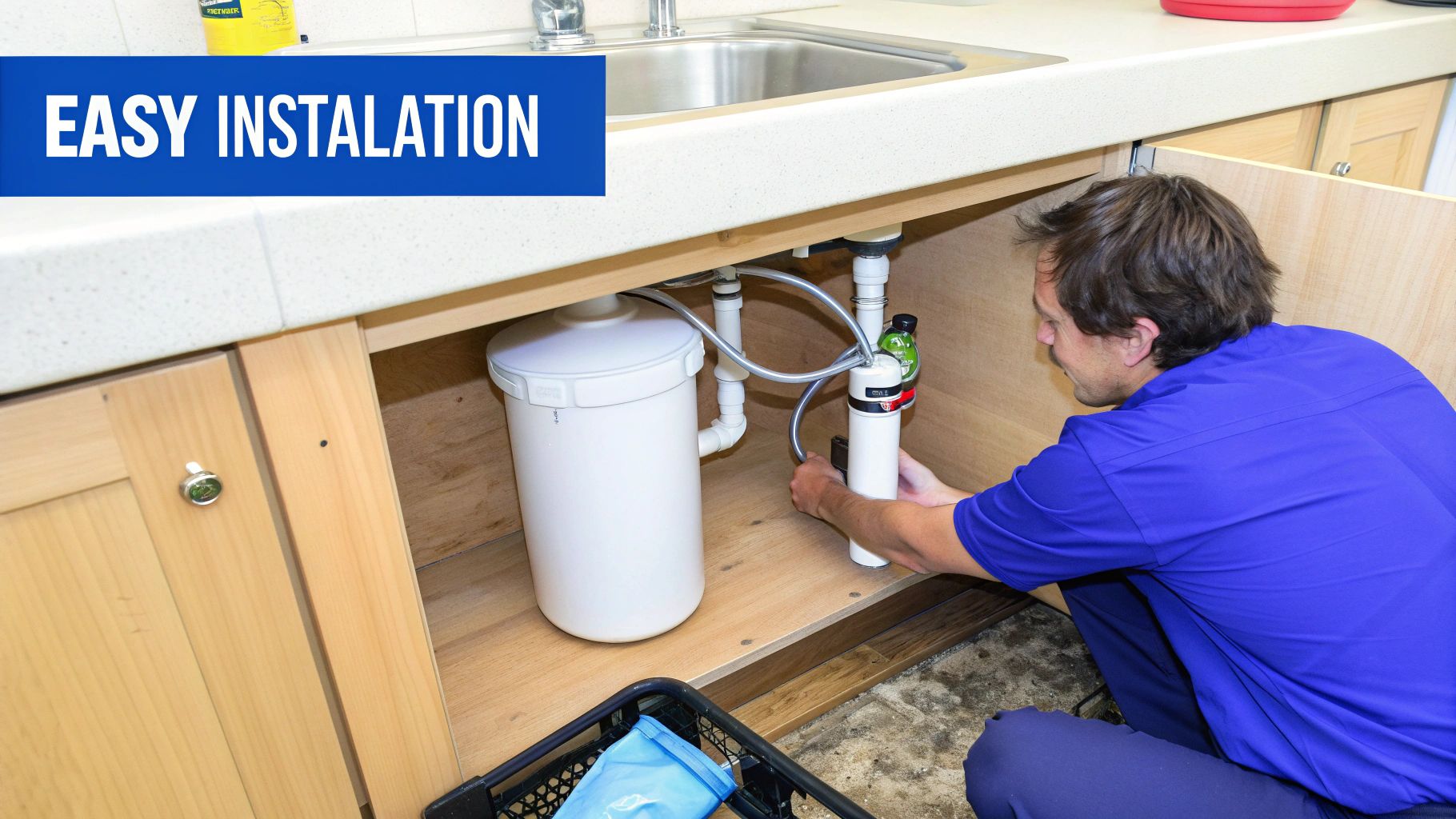If you've landed here, you're probably already aware that getting fluoride out of your water isn't as simple as boiling it or using a standard charcoal filter jug. Those common methods just don't cut it. To really tackle fluoride, you need specific technologies like reverse osmosis, activated alumina filtration, or distillation. These are the heavy hitters capable of properly reducing fluoride levels in your household tap water.
Why Some Australians Choose to Remove Fluoride
Across Australia, water fluoridation is a long-standing public health measure, widely praised for its success in fighting tooth decay over decades. But if you're reading this, you likely have your own questions about the practice and want more control over what’s in your glass.
This isn't just about teeth anymore. It’s a growing conversation that touches on personal health autonomy, concerns about overexposure, and the simple freedom of choice.
For a lot of people, the journey to figuring out how to remove fluoride from water starts with a desire to have the final say. While health authorities stand by fluoridation, some are worried about the total amount of fluoride we get from all sources—not just tap water, but also toothpaste and certain foods.
Personal Health and Ethical Questions
The biggest driver for many is the question of potential health effects beyond dental benefits. Some recent studies have sparked discussions around fluoride's impact on things like thyroid function and neurological development in children. This has led many to take a "better safe than sorry" approach, choosing to minimise their exposure wherever they can.
Then there's the ethical side of it. Some Aussies just aren't comfortable with the idea of a universal medication being added to the public water supply. They believe health decisions should be a personal choice. After all, fluoride is readily available in toothpaste for anyone who wants to use it topically.
This infographic gives a clear snapshot of why people are looking for fluoride removal solutions.

As you can see, health concerns are far and away the number one reason, with taste and ethical principles also playing a big part.
Australia's High Fluoridation Rates
It's worth noting that Australia is one of the most fluoridated countries in the world. As of 2025, about 80% of the population receives fluoridated water. That’s roughly 17.7 million Australians drinking water with added fluoride every day. If you want to see how we stack up globally, you can learn more about global fluoridation statistics.
This widespread practice means that for most people in urban areas, tap water is a constant source of fluoride. So, if you're looking to manage your intake, filtration really is the only practical way to do it.
At its heart, this whole issue often boils down to one thing: control. People want the power to decide for themselves and their families what they consume, shifting from being a passive recipient to an active manager of their own health.
Ultimately, understanding these motivations is the crucial first step. By acknowledging the valid questions people have, we can better explore the practical solutions out there. If you’re keen to learn more, you can explore the remarkable benefits of fluoride removal for safe drinking water in our other article. This background gives you a solid foundation to make a choice that truly aligns with your personal values and health goals.
The Most Effective Fluoride Removal Methods
 When you start looking into removing fluoride from your water, you’ll find a lot of claims out there. Let's cut through the noise. Only a handful of methods are scientifically proven to work, and I want to focus on the three technologies that consistently deliver real results: reverse osmosis, activated alumina, and distillation.
When you start looking into removing fluoride from your water, you’ll find a lot of claims out there. Let's cut through the noise. Only a handful of methods are scientifically proven to work, and I want to focus on the three technologies that consistently deliver real results: reverse osmosis, activated alumina, and distillation.
Understanding how these systems actually work is the key to picking the right one for your home. It’s not just about buying a filter off the shelf; it's about investing in a specific purification process designed to target and remove fluoride ions effectively.
Reverse Osmosis: The Popular Powerhouse
If there's one method that stands out for home use, it's reverse osmosis (RO). It’s probably the most popular and effective way to tackle fluoride, and for good reason. Think of it like a highly selective screen door for water molecules. An RO system uses your home’s water pressure to force tap water through a special semipermeable membrane.
This membrane is incredible. Its pores are so tiny they let pure water molecules pass through but block larger particles like fluoride, chlorine, lead, and a whole host of other contaminants. What you're left with is exceptionally clean drinking water.
A good, modern RO system can reliably remove 90-95% or more of the fluoride in your tap water. That’s a huge reduction, making it a top choice for families who want total peace of mind. They are typically installed right under the sink and connect directly to your tap, so you have a constant supply of purified water on demand.
Key Takeaway: Reverse osmosis physically blocks fluoride and other impurities using a micro-fine membrane. It’s a fantastic all-around solution if you’re looking for comprehensive water purification.
If this sounds like the right fit for you, have a look at the different reverse osmosis systems available to see how they integrate into a modern kitchen.
Activated Alumina: A Targeted Approach
The name "activated alumina" might sound a bit technical, but the process is quite simple. This type of filter uses a highly porous form of aluminium oxide to attract and hold onto fluoride ions. As water flows through the filter cartridge, the fluoride literally sticks to the surface of the alumina media, pulling it out of the water.
This method is highly specific. It’s fantastic at targeting fluoride, arsenic, and selenium, which makes it a great solution if those are your primary concerns.
One thing to keep in mind is that its effectiveness depends heavily on the pH of your water. It works best in slightly acidic water (around a pH of 5.5) and becomes less efficient as the water becomes more alkaline. And don't worry—this isn't the same as the aluminium in your cookware. It’s a specialised, inert material designed purely for filtration.
- High Adsorption: It has a massive surface area-to-weight ratio, letting it grab and hold large amounts of fluoride.
- pH Dependent: Its performance can change depending on your water's chemistry.
- Regenerable Media: In some larger, commercial systems, the media can be cleaned and reused, though this is less common for home units.
Distillation: The Original Purification Method
Water distillation is one of the oldest purification tricks in the book. It basically mimics the Earth’s natural water cycle: evaporation, condensation, and rain.
A distiller works by boiling water, which turns it into steam. Because fluoride and other heavy contaminants aren't volatile, they get left behind in the boiling chamber. The pure water steam is then channelled into a separate chamber where it cools and condenses back into liquid. Pure water.
This process is incredibly effective, removing up to 99% of fluoride along with virtually all other minerals and contaminants. The downside? It's slow and uses a fair bit of energy. Distillers typically only produce small batches of water at a time, making them best for drinking and cooking rather than filtering water for your entire house. You’ll usually find them as simple countertop appliances.
Comparing Fluoride Removal Methods at a Glance
To make the choice a little easier, here’s a quick breakdown of how these three powerhouse methods stack up against each other. Each has its strengths, so the "best" one really depends on your household's needs and budget.
| Method | Effectiveness | Initial Cost | Maintenance | Wastewater |
|---|---|---|---|---|
| Reverse Osmosis | 90-95%+ | Moderate | Regular filter changes | Yes |
| Activated Alumina | 80-90% | Low-Moderate | Regular filter changes | No |
| Distillation | Up to 99% | Moderate | Regular cleaning | No |
Ultimately, whether you choose the comprehensive power of reverse osmosis, the targeted approach of activated alumina, or the classic purity of distillation, you can be confident that you're using a proven method to significantly reduce the fluoride in your family's water.
Finding the Right Filtration System for Your Home

Choosing a system to get fluoride out of your water isn’t just about comparing different technologies. It’s about figuring out what genuinely fits your life. Let's move past the technical jargon and get into the practical side of things, helping you find the perfect setup for your household.
The "best" system is always the one that makes sense for your specific situation. What works wonders for a big family in a standalone house might be completely impractical for someone else.
Let's walk through a couple of real-world scenarios to see how this plays out.
Tailoring Your Choice to Your Lifestyle
Are you renting a small apartment in Melbourne? If so, you're probably limited by your tenancy agreement and a lack of space. A permanent, plumbed-in system is almost certainly off the table. In this situation, a countertop water distiller or a quality water pitcher with a specialised fluoride filter is your best bet. They’re portable, don't need any installation, and handle all your drinking and cooking water needs perfectly.
Now, let’s picture a different scene. You own your home in Perth, you've got a family of four, and your daily water use is pretty high. For you, an under-sink reverse osmosis (RO) system is a much more practical long-term investment. It provides a constant stream of purified water right from the tap and stays neatly tucked away, so you don't lose any precious counter space.
If you want to explore the options even further, you can find some more comprehensive water filtration advice to help you weigh up the pros and cons.
Key Factors to Consider
Before you pull the trigger on a purchase, it's smart to think through a few key variables. Nailing these down will save you from buying something that's either total overkill or just not up to the job.
- Your Budget: The initial outlay can be anything from under $100 for a decent pitcher to over $1,000 for a whole-house setup. And don't forget to budget for ongoing costs like replacement filters.
- Available Space: Do you actually have room under the sink for an RO system's tank and cartridges? Or would a compact countertop model be a much better fit for your kitchen?
- Ease of Installation: Are you a confident DIYer, or does the thought of plumbing fill you with dread? Some systems are surprisingly simple to install yourself, but others are best left to a professional.
- Daily Water Needs: A single person has totally different needs than a big family. Try to estimate how much purified water you'll get through each day for drinking, cooking, and making coffee or tea.
Real-World Tip: Before you even start shopping, get under your sink and measure the space you have to work with. Snap a quick photo on your phone so you have the dimensions handy. It's a simple step that can prevent a massive headache later on.
Interestingly, it’s worth noting that fluoride removal isn't a common public service in Australia. Since 1953, the country's public health strategy has focused on adding fluoride to water supplies to prevent tooth decay, a policy set to continue through to 2025. This context helps explain why finding reliable removal solutions is something you have to tackle yourself.
Ultimately, making the right choice is about balancing effectiveness with pure practicality. For a deeper dive into matching a system to your home or business, check out our guide on choosing the right water filtration system. By taking the time to consider these factors, you can confidently pick a filtration system that not only gets the job done but also fits seamlessly into your home and lifestyle.
Installation and Maintenance You Can Actually Do

A top-tier filtration system is only as good as its installation and upkeep. It's one thing to invest in a quality unit, but making sure it's set up and maintained correctly is what really guarantees you'll get that clean, fluoride-reduced water you're after.
This might sound a bit daunting, especially if you're not a plumber. But for many systems, like the popular under-sink models, the process is surprisingly straightforward for anyone who's comfortable with basic DIY. Let's walk through what a typical installation looks like and create a simple maintenance schedule to keep everything running perfectly.
Getting the Installation Right
Most under-sink systems come with a decent set of instructions, but a few common slip-ups can cause some real headaches down the line.
One of the most frequent mistakes I see is people mixing up the hot and cold water lines. It's a simple error, but it's critical: your filter should only ever connect to the cold water supply. Hot water can wreck the filter membranes and seriously reduce their effectiveness.
Another little detail to watch is seating the new filtered water tap correctly on your sink or benchtop. Make sure the gaskets are properly in place and the nut underneath is tightened securely. This prevents those slow, annoying leaks that you might not notice for weeks. A small step that saves a lot of trouble.
Now, if the thought of touching your plumbing makes you break out in a cold sweat, there’s absolutely no shame in calling a professional. What might be a quick job for a plumber can give you total peace of mind. If you decide you'd rather leave it to the experts, you can easily schedule a service appointment to get it done right.
Key Takeaway: Always read the manufacturer's instructions from start to finish before you even touch a tool. It sounds obvious, but taking ten minutes to get familiar with the process can prevent hours of frustration.
A Simple Maintenance Checklist
Once your system is up and running, consistent maintenance is completely non-negotiable. This isn't just about keeping fluoride out; it’s about preventing bacterial growth and protecting the money you've invested. Sticking to the manufacturer's schedule is the best way to go.
Here’s a simple checklist to get you started:
- Filter Change Schedule: This is the big one. Mark your calendar for filter changes. Pre-filters might need replacing every six months, while the main reverse osmosis membrane could last two to three years.
- System Sanitation: At least once a year, usually when you change the main filters, it’s a great idea to sanitise the system. This typically involves running a special cleaning solution through the unit to kill off any potential bacteria.
- Regular Leak Checks: Every couple of months, just take a quick peek under the sink with a torch. Check all the connection points for any signs of moisture or slow drips. Catching a tiny leak early is so much better than dealing with water damage later.
Following these steps will ensure your system keeps performing at its peak. For a more detailed breakdown, our guide on how to maintain a water filter to prolong its life offers some extra tips. Remember, neglecting maintenance doesn't just mean you might be drinking fluoride again; it can lead to clogs, poor water flow, and even damage the whole system.
Myths About Water Filtration We Need to Bust
Trying to figure out water filtration can feel a bit overwhelming, especially with so much conflicting information floating around. It's easy to waste time and money on methods that just don't cut it when it comes to fluoride removal. Let's clear the air and tackle some of the most common myths I hear all the time.
One of the biggest misconceptions is that standard charcoal pitcher filters—like the Brita jugs you see in so many Aussie homes—can get rid of fluoride. While they’re fantastic for making your water taste and smell better by reducing chlorine, their activated carbon media does not capture fluoride ions. For that, you need specialised filter technology.
Another one that just won't go away is the idea that boiling water will purify it of fluoride. In fact, boiling does the complete opposite. As the water evaporates into steam, the fluoride and other minerals get left behind, making them even more concentrated in the water that's left.
Debunking 'Dead Water' and Other Concerns
You might have come across the term "dead water" when people talk about reverse osmosis or distillation systems. The argument goes that by stripping out all the minerals, the water becomes unnatural or unhealthy. And while it's true these powerful methods remove almost everything—including good stuff like calcium and magnesium—the worry is usually overblown.
The concept of "dead water" is more of a marketing term than a scientific one. The vast majority of essential minerals come from our food, not our drinking water. However, for those who want the best of both worlds, there's a simple fix.
Many modern reverse osmosis systems now come with a remineralisation stage. This is a final filter that adds a healthy balance of minerals back into the purified water, which also improves its taste and pH balance. It’s a simple addition that completely resolves any concerns about "dead water," giving you pure, great-tasting water that's also rich in healthy minerals.
This whole discussion is part of a much larger, ongoing conversation here in Australia. Public opinion on water fluoridation has certainly evolved over the decades, with local communities sometimes debating whether to continue with it. If you're curious, you can read more about public surveys on fluoridation in Western Australia to get a sense of the local perspective.
Your Questions on Fluoride Removal Answered
Once you start digging into how to remove fluoride from your water, a few key questions always seem to surface. Let's tackle the most common ones so you can feel completely confident before making a decision.
A big one we hear a lot is whether powerful systems like reverse osmosis (RO) or water distillers also strip out the good stuff—the beneficial minerals. The short answer is, yes, they often do. These methods are so thorough that they remove almost everything from the water, which includes healthy minerals like calcium and magnesium.
But that's an easy fix. Most modern RO systems these days come with a dedicated remineralisation filter. This is the final stage of the process, adding a balanced blend of essential minerals back into the purified water, which also improves its taste and pH level.
Checking Your System and Budgeting for Costs
So, you've got your new filter. How can you be sure it's actually doing its job?
A great way to see the results for yourself is to test your water's fluoride levels both before and after installation. You can find home testing kits online, or for a more precise reading, you can send a water sample off to a specialised laboratory. This gives you hard proof of just how much fluoride is being removed.
It's also smart to think about the long-term running costs. The real annual cost of maintaining a reverse osmosis system in Australia typically falls between $150 and $300. This covers replacement sediment and carbon pre-filters (which you'll usually change every 6-12 months) and the main RO membrane, which can last 2-3 years. Budgeting for these ongoing costs is the key to making sure your system keeps performing at its best.
Planning for filter changes and testing your water puts you in full control of your home's water quality. It ensures your investment delivers the results you expect for years to come.
For more detailed answers to common queries, our extensive frequently asked questions page is an excellent resource.
Ready to enjoy pure, great-tasting water at home? Explore the full range of filtration solutions from Awesome Water® and find the perfect system for your family today at https://www.awesomewater.com.
Article created using Outrank

